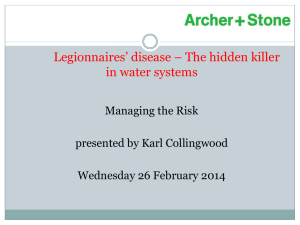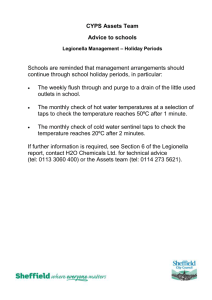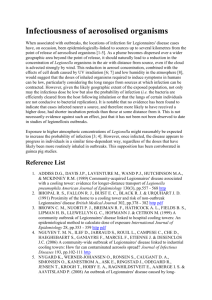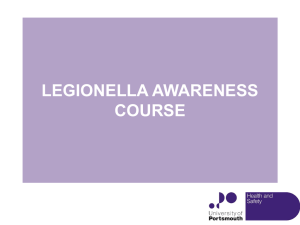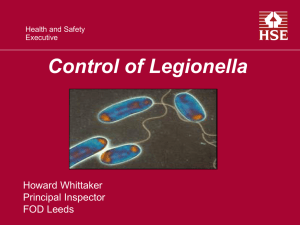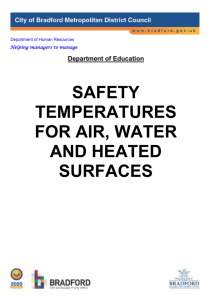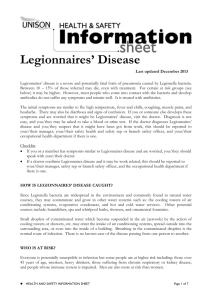Legionnaires Disease Pathogenicity and Design
advertisement
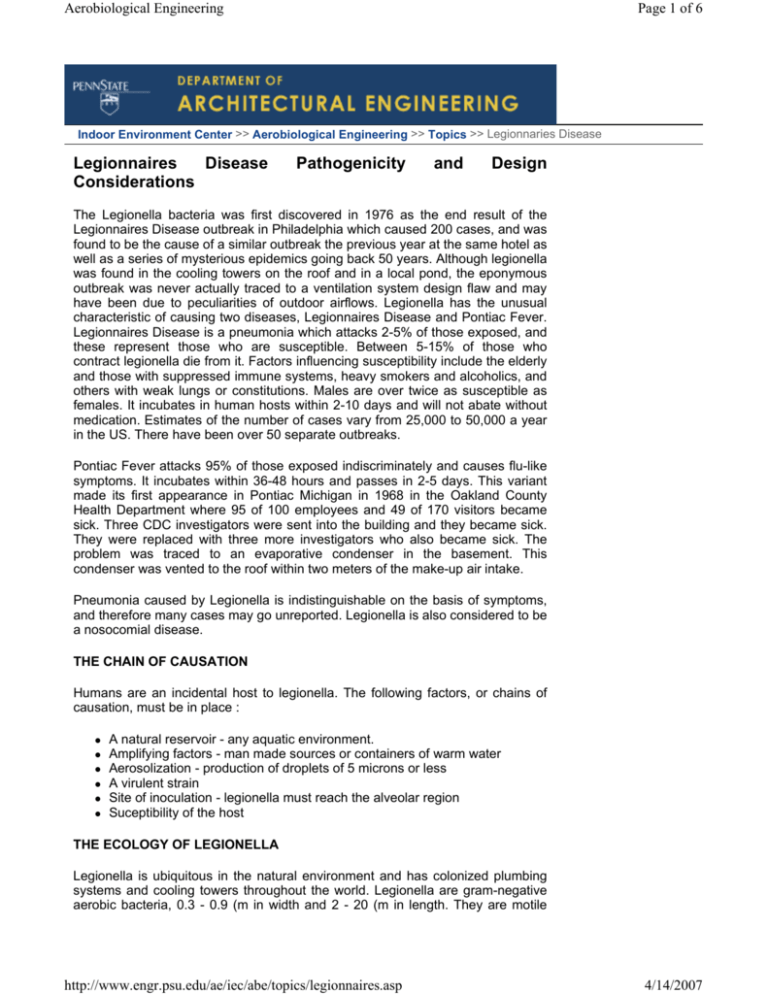
Aerobiological Engineering Page 1 of 6 Indoor Environment Center >> Aerobiological Engineering >> Topics >> Legionnaries Disease Legionnaires Disease Considerations Pathogenicity and Design The Legionella bacteria was first discovered in 1976 as the end result of the Legionnaires Disease outbreak in Philadelphia which caused 200 cases, and was found to be the cause of a similar outbreak the previous year at the same hotel as well as a series of mysterious epidemics going back 50 years. Although legionella was found in the cooling towers on the roof and in a local pond, the eponymous outbreak was never actually traced to a ventilation system design flaw and may have been due to peculiarities of outdoor airflows. Legionella has the unusual characteristic of causing two diseases, Legionnaires Disease and Pontiac Fever. Legionnaires Disease is a pneumonia which attacks 2-5% of those exposed, and these represent those who are susceptible. Between 5-15% of those who contract legionella die from it. Factors influencing susceptibility include the elderly and those with suppressed immune systems, heavy smokers and alcoholics, and others with weak lungs or constitutions. Males are over twice as susceptible as females. It incubates in human hosts within 2-10 days and will not abate without medication. Estimates of the number of cases vary from 25,000 to 50,000 a year in the US. There have been over 50 separate outbreaks. Pontiac Fever attacks 95% of those exposed indiscriminately and causes flu-like symptoms. It incubates within 36-48 hours and passes in 2-5 days. This variant made its first appearance in Pontiac Michigan in 1968 in the Oakland County Health Department where 95 of 100 employees and 49 of 170 visitors became sick. Three CDC investigators were sent into the building and they became sick. They were replaced with three more investigators who also became sick. The problem was traced to an evaporative condenser in the basement. This condenser was vented to the roof within two meters of the make-up air intake. Pneumonia caused by Legionella is indistinguishable on the basis of symptoms, and therefore many cases may go unreported. Legionella is also considered to be a nosocomial disease. THE CHAIN OF CAUSATION Humans are an incidental host to legionella. The following factors, or chains of causation, must be in place : z z z z z z A natural reservoir - any aquatic environment. Amplifying factors - man made sources or containers of warm water Aerosolization - production of droplets of 5 microns or less A virulent strain Site of inoculation - legionella must reach the alveolar region Suceptibility of the host THE ECOLOGY OF LEGIONELLA Legionella is ubiquitous in the natural environment and has colonized plumbing systems and cooling towers throughout the world. Legionella are gram-negative aerobic bacteria, 0.3 - 0.9 (m in width and 2 - 20 (m in length. They are motile http://www.engr.psu.edu/ae/iec/abe/topics/legionnaires.asp 4/14/2007 Aerobiological Engineering Page 2 of 6 with 2 or more polar flagella. There are 40 species in the family of Legionella bacteria in the world. Although 12 of these species have been implicated in human disease, some 90% of disease cases are caused by Legionella Pneumophila. There are 15 serogroups of Legionella Pneumophila and most cases are associated with sero group 1. There are five subgroups of this serogroup which have different degrees of virulence. The specific sub-typing of legionella is useful mainly in prosecutory litigation. In the natural aquatic environment, legionella feeds on various nutrients but is most adept in the role of an intracellular parasite on other bacteria. Once it is uptaken by, or insinuates itself in, a larger bacteria it resists bacterial defenses and then multiplies. Legionella derives essential nutrients from the water and from other bacteria. L-cysteine and iron salts are required for growth. Legionella belongs to a special group of bacterial pathogens that evade host defenses by parasitizing phagocytes. This group also includes Tuberculosis bacteria and salmonella. Legionella can be found in natural hot springs, such as at Yellowstone, where they have been found in samples dating back to the early 1900's. THE PATHOGENICITY OF LEGIONELLA The species of bacteria has been named Legionella Pneumophila, which means "lung-loving". In a human host legionella must feel as if it is right at home in a warm pond waiting for some hapless amoeba to come along and try to swallow it. It avoids ciliary clearance through the use of its polar flagella. It resists immune system defenses in the lungs by cleavage of immunoglobulins, a characteristic of most bacteria. The primary lung defense at the cellular level includes phagocytes and alveolar macrophages, which attempt to ingest the invader. The result in this case is a highly unusual process. After surrounding and engulfing the legionella, the phagocyte or macrophage fails to digest it. Instead, the legionella parasitizes the phagocyte and begins multiplying as if it were in a bacterial host in its natural environment. After doubling its numbers every 2 hours, eventually hundreds of legionella overload the phagocyte and it ruptures. Ethromycin, an antibiotic, does not kill the legionella, but prevents it from multiplying intracellularly, giving the immune system a chance to gain the upper hand. LEGIONELLA AND THE RESPIRATORY SYSTEM One part of the Causative Chain requires that Legionella penetrate deeply into the lungs, to the alveolar (gas exchange) region. The deposition of airborne http://www.engr.psu.edu/ae/iec/abe/topics/legionnaires.asp 4/14/2007 Aerobiological Engineering Page 3 of 6 particles in the human respiratory tract is governed primarily by the size of the particle as shown by the following rough breakdown: z z z z z Particle Size Deposition Area > 10 (m Nose & Throat between 5-10 (m Upper & Lower Respiratory Tract between 2-5 (m Lung & Conducting Airways < 2 (m Gas Exchange Area Cilia in the upper part of the respiratory tract normally expel the particles, except amongst smokers and alcoholics, where the process is muted. LEGIONELLA IN AIR AND WATER SYSTEMS The diagram below illustrates the range of temperatures within which Legionella survives and thrives. This chart also indicates the approximate temperature range of a number of common systems and types of equipment. It can be seen that spas, showers and cooling towers happen to fall exactly within the optimum growth range of Legionella. It can also be seen that evaporative coolers, cooling coils and hot water systems are outside the range needed for Legionella amplification. Environmental conditions which promote the growth of Legionella are: 1. Water temperatures between 20 -50 deg C (68-122 deg F). 2. Optimal growth occurs at temperatures between 35-46 deg C (95-115 deg F). 3. Stagnant water. 4. A pH range of 2.0 to 8.5. 5. Sediment in water which supports the growth of supporting microbiota. 6. Microbiota including algae, protozoa and others. 7. The presence of L-cysteine-HCL and iron salts. http://www.engr.psu.edu/ae/iec/abe/topics/legionnaires.asp 4/14/2007 Aerobiological Engineering Page 4 of 6 The two most frequent sources of Legionella are neglected cooling towers and domestic hot water systems. Most equipment becomes contaminated through potable water supplies. Bacteria die off quickly upon drying out in an aerosol and also from UV exposure on sunny days, but Legionella survives well in aerosols in comparison with other bacteria. Airborne Legionella survive over greater distances when the relative humidity is 65% or greater. The risk of Legionnaires Disease drops off exponentially when one is 0.5 km or more from a cooling tower. The infective range is from 500 to 1000 meters. AMPLIFIERS AND DISSEMINATORS 1. 2. 3. 4. 5. 6. 7. 8. 9. Cooling Towers Evaporative Condensers Domestic Hot Water Systems Spas & Whirlpools Humidifiers Decorative Fountains Reservoir Misters in supermarkets Portable Cooling Units with stagnant water Faucets and showerheads Cooling Towers and Evaporative Condensers Large-scale industrial cooling towers used in electricity generation have never yet been implicated in legionnaires disease. Water quality is strictly controlled in these facilities as part of normal maintenance. Legionella outbreaks are inevitably linked to neglected A/C cooling towers. Cooling towers in metropolitan areas are difficult to keep clean and usually operate about 35 deg C. They receive hot water from condensers and spray it over a fill material through which air is forced in counterflow to the water. As condensation tends to occur around dust and particles the result is that evaporative coolers have a filtering effect on the air and collect dirt in the water. Biocides are normally used in these evaporative coolers but excess dirt can inhibit the biocide effectiveness. Also, due to changing operating temperatures and conditions, the levels of bacteria in cooling tower water can fluctuate in a cyclical manner. The application of biocides needs to be timed appropriately. A distinction needs to be made between evaporative coolers and cooling towers & evaporative condensers, a point about which there is some confusion in the literature. Cooling towers and evaporative condensers have both been implicated in legionnaires disease. Evaporative coolers have not. Hot Water Systems The two critical factors for domestic water services are water cleanliness and water temperature. Dirty water provides a food supply for the bacteria. Colonization is most likely between 35-40 deg C (95-104 deg F). General Design Recommendations 1. Assume that all incoming water contains legionella bacteria. 2. Establish the operating range of temperatures both during operating conditions and otherwise. http://www.engr.psu.edu/ae/iec/abe/topics/legionnaires.asp 4/14/2007 Aerobiological Engineering 3. 4. 5. 6. 7. 8. 9. 10. 11. 12. 13. Page 5 of 6 Identify potential for aerosolization and consider the prevention thereof. Avoid long-term storage of water. Dispersal of aerosols should be away from occupied places Precautionary measures should be taken for persons of high susceptibility Insulation of cold water supply piping if the water is too warm. Keep indoor relative humidity below 70%. Where cold indoor surfaces are present, keep humidity below 50%. Humidification should be accomplished with cold water systems. Drain pans should be of a type that drain completely. Addition of biocides should be done in low amounts frequently rather than large amounts less often. Avoid or minimize the use of reservoirs, sumps and drain pans. Natural rubbers, sealing washers & gaskets have all been found to support the growth of legionella, use of these should be minimized. Design Recommendations for Hot Water Systems 1. In the case of hot water supplies insulation or a higher flow rate (to minimize temperature drop) 2. Higher operating temperature. 3. Keep hot water at or above 50 deg C (122 deg F) or below 20 deg C (68 deg F). 4. Long pipe runs and collection tanks where water may stagnate should be avoided. Design Recommendations for Cooling Towers 1. Designing in small ozonization units. 2. Designing in, or replacement with, dry convective heat exchangers. 3. Air intakes should be located at least 100 meters from cooling towers to minimize entry of cooling tower drift into the air inlets. 4. Design evaporative cooling systems such that the failure of of the heat exchanger will not result in the mixing of the wet system with the supply air. WATER TREATMENT Legionella is more resistant to chlorine and microbial biocides than other microorganisms. Chlorine is an effective treatment, however, because it destroys the food supply of Legionella. Care must be used in the selection of biocides and they must be used consistently and in appropriate quantities. Refer to the various references on water treament for more information. Additional information on water treatment may be obtained from Tower San Systems. REFERENCES 1. Legionella : Proceedings of the 2nd International Symposium, American Society for Microbiology, C.Thornsberry, A.Balows, J.Feeley, W.Jakubowski, 1984. 2. Pathogenetic Aspects of Legionnaires Disease, C.Rechnitzer, APMIS 1994. 3. Complying With the Code of Practice on Legionella, G.Brundett, Power Engineering Journal, Dec. 1994. 4. ASHRAE White Paper : Position Paper on Legionellosis, 1995. 5. Biological Contaminants in Indoor Environments, Morey, Feeley, Otten, http://www.engr.psu.edu/ae/iec/abe/topics/legionnaires.asp 4/14/2007 Aerobiological Engineering Page 6 of 6 ASTM 1990. 6. Atmospheric Microbial Aerosols, Lighthart & Mohr, C&H 1994. 7. Bioaerosols Handbook, Cox & Wathes, CRC Press 1995. 8. Architectural Design and Indoor Microbial Pollution, Kundsen, Oxford Press, 1988. 9. Why Evaporative Coolers Have Not Caused Legionnaires Disease, Puckorius, Thomas & Augspurger, ASHRAE Journal January 1995. 10. Controlling Legionella in Cooling Towers, J.M.Barbaree, ASHRAE Journal June 1991. 11. Legionnaires Disease Questions & Answers, Centers for Disease Control, The World Wide Web / Internet 1995. 12. Barbaree, J.M. 1991. Legionnaires disease factors affecting the transmission of Legionella species. ASHRAE J. June 1991, 33:38-42 13. Fliermans, C.B. 1987 Maintaining industrial cooling systems free of Legionella. Transactions of ASHRAE 93:NT-87-09-4 14. McBurney, K. 1990. Maintenance suggestions for cooling towers. ASHRAE J. 32:16-26 15. Meitz, A. 1986. Clean cooling systems minimize Legionella exposure. HPAC 58:99-102. 16. Meitz, A. 1988. Microbial life in cooling water systems. ASHRAE J. 30:2530. http://www.engr.psu.edu/ae/iec/abe/topics/legionnaires.asp 4/14/2007
